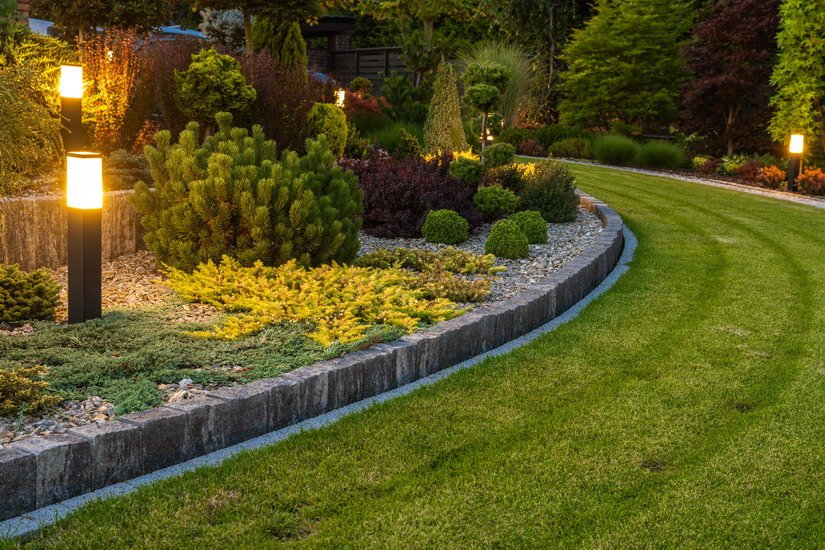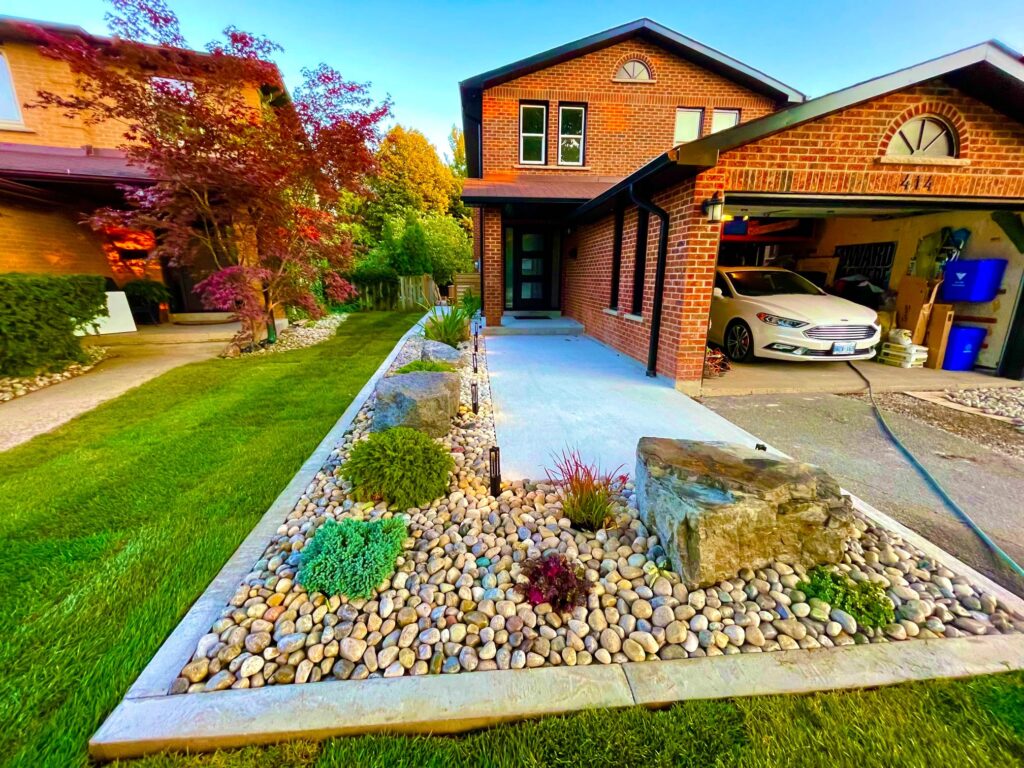Understanding the Comprehensive Range of Functions in Professional Landscape Design Services
The extensive extent of professional landscape design services incorporates a variety of essential components. It includes landscape style concepts, plant selection, and hardscaping features. Furthermore, it attends to irrigation systems and maintenance techniques. Each element plays an important duty in creating functional and visually pleasing outside spaces. Recognizing how these components interact can expose much concerning the art and science of landscaping. Nonetheless, the journey right into this intricate area is simply beginning.

Landscape Design Concepts
Effective landscape layout principles are vital for creating harmonious exterior spaces that improve both visual allure and capability. These concepts guide the plan of aspects within the landscape, making certain a natural aesthetic experience. Trick parts consist of balance, which distributes aesthetic weight equally; percentage, which associates the dimension of various aspects to every various other and the room; and unity, which creates a sense of integrity via consistent styles and products.
Furthermore, focus directs focus to prime focus, while rhythm develops movement through repeating of layout functions. The effective use line can produce pathways and guide the eye through the landscape. On top of that, comprehending the website's topography, environment, and existing functions is vital for integration with the surrounding environment. By sticking to these foundational principles, landscape designers can craft areas that not only look appealing yet likewise offer their intended objective, enhancing the total experience for customers.
Plant Selection and Installment
In the domain of specialist landscaping, plant choice and installation play a vital duty in accomplishing a flourishing yard - landscaping services. Stressing native plant benefits, seasonal considerations, and the particular dirt and sunlight needs of each species guarantees a sustainable and aesthetically pleasing landscape. Mindful preparation in these areas not only enhances biodiversity but additionally advertises long-lasting ecological wellness
Native Plant Advantages
Why should property owners consider indigenous plants for their landscaping jobs? Native plants offer countless advantages that enhance both aesthetic appeals and environmental sustainability. They are well-adapted to local environments, needing less water and upkeep compared to non-native varieties. This strength decreases the need for chemical plant foods and pesticides, advertising a healthier environment. Additionally, native plants supply habitat and food for local wild animals, including pollinators, which can enhance biodiversity in property areas. Their familiarity with neighborhood dirt and weather conditions additionally results in much better growth rates and durability. By choosing native plants, house owners not just create aesthetically appealing landscapes but additionally contribute to ecological preservation, making a positive impact on their neighborhood setting. Subsequently, native plants represent a smart choice for landscaping projects.
Seasonal Plant Considerations
Property owners that have accepted native plants in their landscaping can better improve their outdoor rooms by taking into consideration seasonal plant options. By incorporating plants that thrive in specific periods, they can develop dynamic and aesthetically appealing landscapes throughout the year. Spring may usher in vibrant flowers like daffodils and tulips, while summertime can showcase lush vegetation and vibrant perennials. Fall introduces a palette of cozy tones with goldenrods and asters, while winter season can be accentuated with evergreens and ornamental turfs for structure. Expert landscapers commonly advise selecting plants that not just enhance existing indigenous species yet additionally offer year-round rate of interest and assistance local wild animals. This thoughtful approach to seasonal plant choice ensures a constantly developing and lasting garden atmosphere.
Soil and Sunshine Requirements
Successful landscaping pivots on comprehending the particular soil and sunshine needs of plants. Various varieties thrive under varying conditions, calling for a mindful evaluation of both elements throughout the selection process (landscaping services). Dirt kinds, such as sandy, clay, or loamy, influence water drainage, vitamins and mineral accessibility, and root advancement. Additionally, pH levels can influence plant health and wellness, requiring soil screening to ascertain viability. Sunlight needs differ considerably; some plants flourish completely sunlight, while others choose partial or full color. A professional landscaping company considers these aspects to assure peak development and aesthetic appeal. By straightening plant options with the environment's certain attributes, landscapes can accomplish sustainability, strength, and aesthetic harmony, inevitably bring about effective plant facility and long-lasting upkeep
Hardscaping Functions and Construction
While landscape design usually evokes pictures of rich greenery and vivid flowers, hardscaping attributes play a vital role in specifying outside areas. These components, which include outdoor patios, pathways, preserving walls, and ornamental stonework, offer structure and capability to backyards and yards. Hardscaping makes use of products such as concrete, block, rock, and timber, permitting varied designs that enhance the all-natural landscape.
The construction of hardscaping functions needs mindful planning and execution to guarantee longevity and aesthetic appeal. Experts evaluate site problems, water drainage, and spatial connections to create cohesive outdoor settings. Appropriate installation strategies are vital, as they protect against issues like erosion and moving in time.
Integrating hardscaping not just enhances the aesthetic rate of interest of a residential or commercial property yet additionally facilitates exterior activities, making it an essential element of thorough landscaping services. Inevitably, thoughtful hardscaping adds to both the performance and beauty of outdoor spaces.
Irrigation Solutions and Water Monitoring
Reliable watering systems and water administration are important components of expert landscaping, as they guarantee that plants receive the essential hydration for ideal development. These systems can vary from basic drip irrigation setups to sophisticated computerized lawn sprinkler systems, created to meet the specific demands of varied landscapes. Appropriate water management not only optimizes water usage, lowering waste, however likewise boosts plant wellness and minimizes condition dangers.
Landscaping specialists examine different factors, including dirt kind, plant varieties, and neighborhood climate, to establish customized watering remedies. Additionally, integrating rain harvesting strategies can better enhance sustainability and performance (Learn More). Normal maintenance of irrigation systems is vital to keep capability and stop leaks, which can cause water loss and increased expenses. Ultimately, a properly designed watering system plays a crucial function in protecting the visual charm of outdoor areas while advertising eco-friendly stewardship within expert landscape design techniques
Grass Treatment and Upkeep Strategies
Lawn care and maintenance methods are essential for attaining a lavish, healthy and balanced backyard that improves the general landscape. These techniques include various practices focused on promoting ideal growth and aesthetic charm. Regular mowing is important, as it motivates thick, even development while avoiding weeds from establishing. Additionally, proper fertilizing gives essential nutrients, with applications tailored to the particular turf type and dirt problems.
Watering methods ought to concentrate on deep, irregular irrigation to urge origin advancement, while aeration boosts dirt framework and promotes nutrient absorption. Parasite and illness management is also important; recognizing issues early permits reliable treatments that lessen damages.
Ultimately, overseeding can rejuvenate thin or damaged grass, enhancing density and color (landscaping services). By applying these targeted lawn care strategies, landscape design professionals can guarantee that yards remain dynamic and healthy throughout the periods, considerably adding to the overall beauty of the home
Seasonal Landscape Treatment and Upkeep
As the periods change, correct landscape care ends up being important for keeping the health and wellness and charm of exterior spaces. Each season offers unique difficulties and requirements. In spring, landscape specialists concentrate on pruning, growing, and fertilizing to motivate development. Summer demands routine watering, weed control, and parasite management to shield newly established plants.
Autumn needs the prep work of yards for winter season, consisting of mulching, fallen leave elimination, and the growing of bulbs for the next springtime. Additionally, wintertime treatment entails shielding vulnerable plants from frost and guaranteeing that hardscapes are risk-free and useful.
Throughout the year, seasonal landscape upkeep assurances that outside areas remain visually appealing and healthy. Professional services can give tailored upkeep plans that adjust to the specific demands of each season, allowing home proprietors to delight in vibrant landscapes year-round. Generally, seasonal treatment is a crucial facet of expert landscape design that advertises durability and aesthetic value.
Lasting Landscape Design Practices
An expanding number of home proprietors are embracing lasting landscape design methods to create ecologically friendly outside rooms. These practices focus on preserving sources, improving biodiversity, and decreasing environmental impact. Indigenous plants are commonly selected for their low water demands and compatibility with local ecosystems, decreasing the requirement for chemical plant foods and chemicals. Rain yards and absorptive paving are used to manage stormwater runoff, promoting groundwater recharge and lowering erosion.
Furthermore, lasting landscape design integrates organic gardening methods that prioritize dirt health and wellness and advertise natural pest control. Effective watering systems, such as drip watering and rainwater harvesting, aid maximize water use. In addition, landscape developers progressively support for using recycled products, such as redeemed wood and stones, to minimize waste. By taking on these lasting methods, homeowner not you could look here just add to ecological preservation yet also create visually pleasing environments that can prosper with very little maintenance.
Often Asked Questions
The length of time Does a Landscaping Job Generally Require To Complete?
Commonly, a landscape design project can take anywhere from a couple of days to several weeks to complete, depending on the task's intricacy, size, and layout demands. Read More. Factors such as weather condition and resource schedule also influence timelines
What Factors Impact the Cost of Landscape Design Services?
Different variables influence landscaping service expenses, consisting of project size, layout complexity, worldly top quality, labor costs, geographic location, and seasonal demand. Each aspect adds uniquely to the total monetary needs of a landscape design task.
Are Landscaping Solutions Available Year-Round?
Landscaping services are typically readily available year-round, although accessibility may vary based on region, seasonal climate condition, and particular solution offerings. Some services could be limited during severe weather or off-peak seasons.
Do Landscape Design Companies Offer Guarantees on Their Job?

Can I Style My Landscape Without Expert Help?
Yes, people can make their landscapes without expert assistance. However, they might lack knowledge in plant selection, format, and environmental considerations, possibly resulting in much less efficient layouts that can call for costly modifications later.
